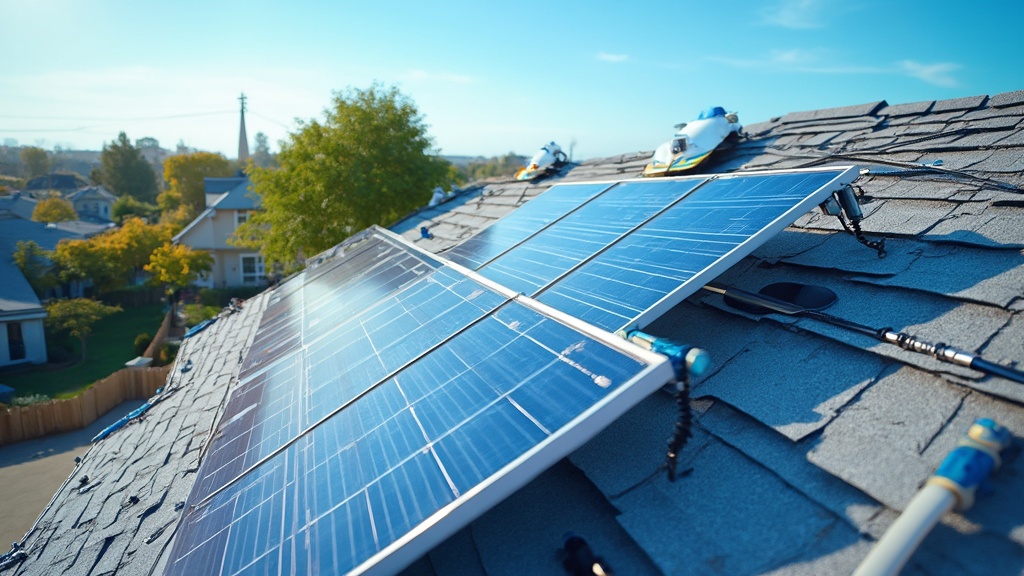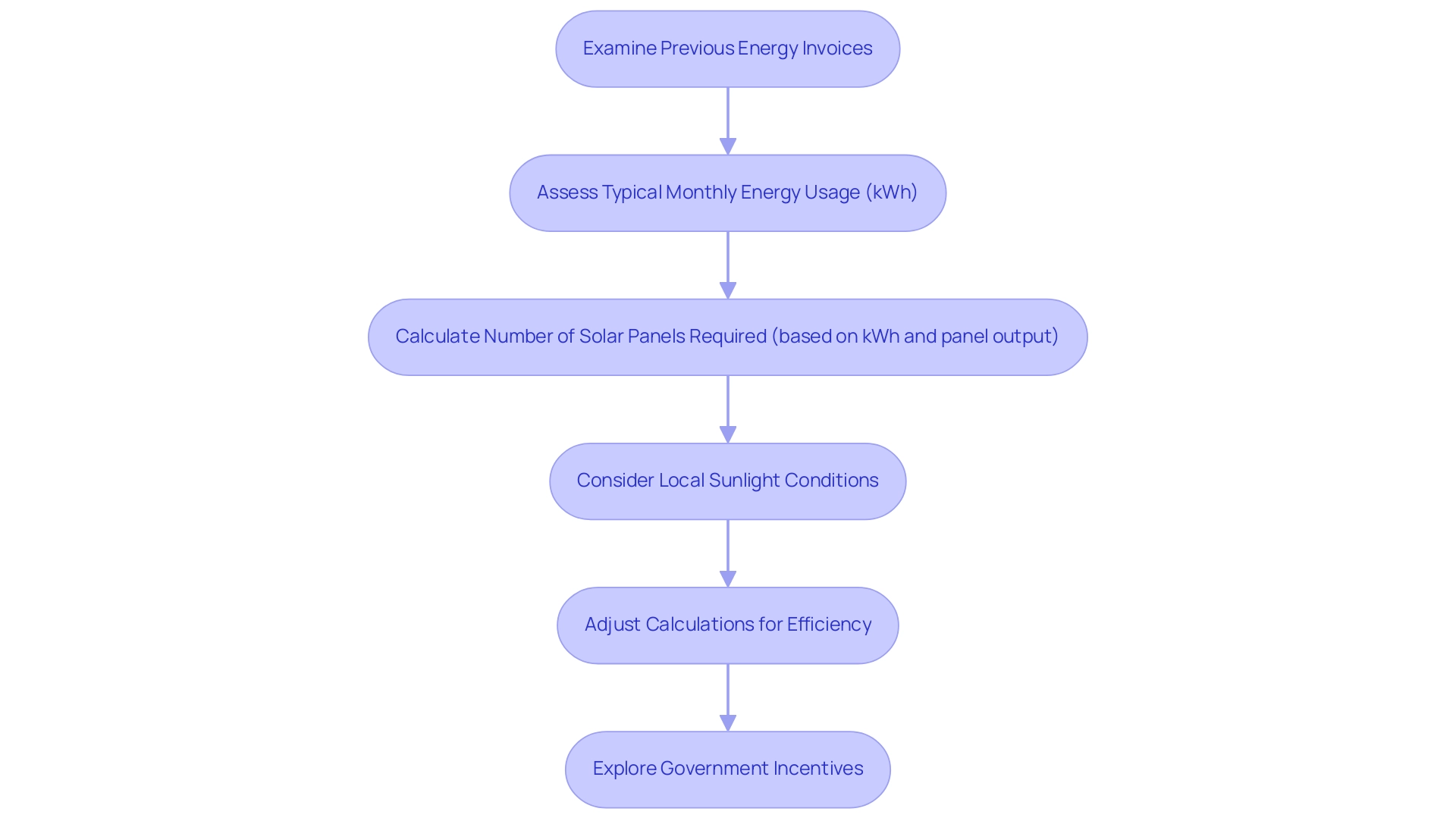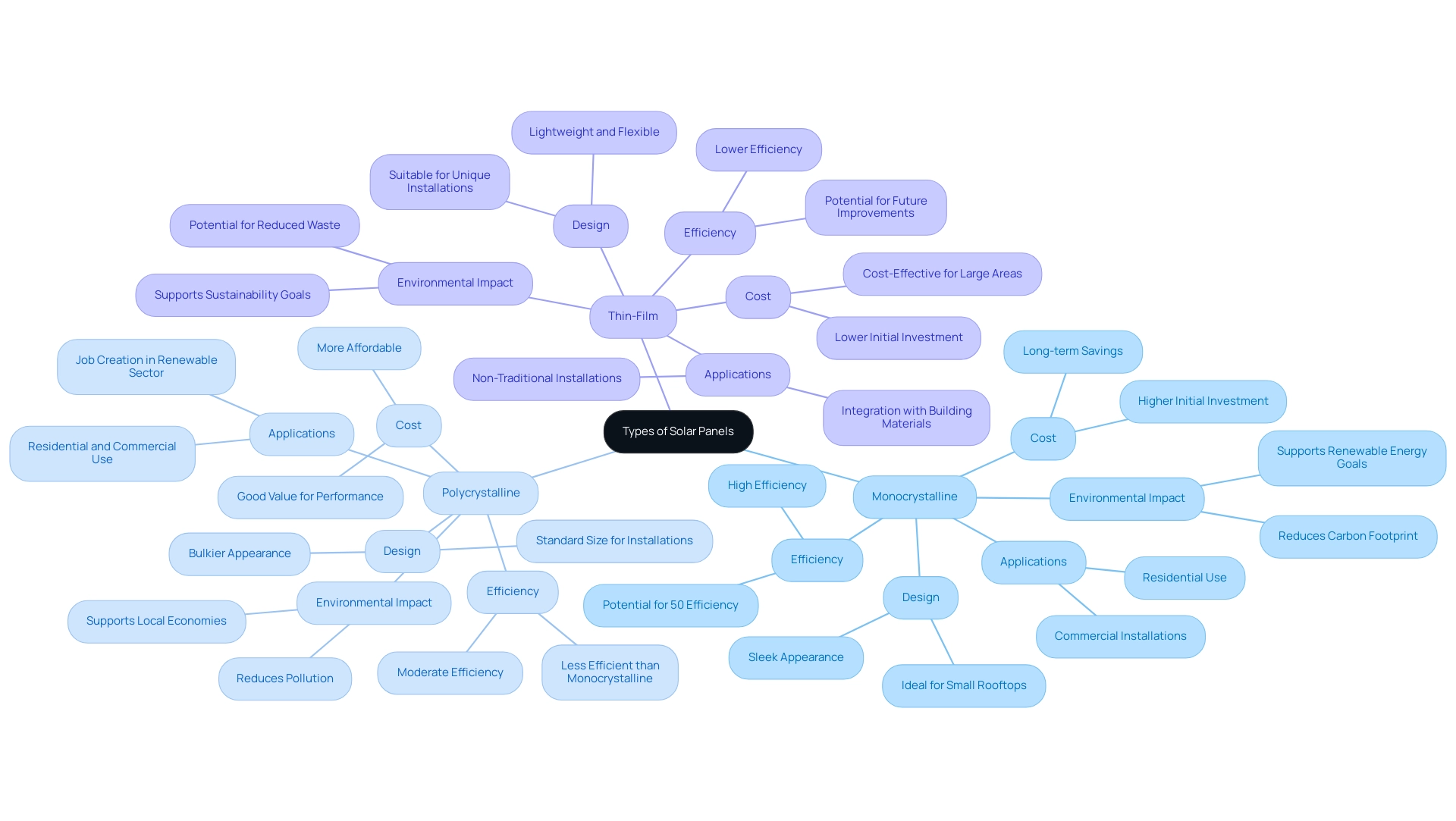Introduction
Exploring the world of solar energy can feel like stepping into a new frontier, especially for homeowners eager to harness the sun’s power while reducing their carbon footprint. With so many options available, understanding the various components of solar panel systems is crucial.
From the sizes and types of panels to the structural requirements of roofs, each element plays a significant role in determining the best fit for a home. As families weigh their energy needs against available space, they will discover how thoughtful planning can lead to both efficiency and savings.
This guide will illuminate the essential considerations for:
- Selecting the right solar panels
- Assessing roof suitability
- Making informed decisions that contribute to a sustainable future
Whether it’s navigating government incentives or understanding the latest technology, homeowners are invited to embark on this enlightening journey toward renewable energy.
Understanding Solar Panel Sizes for Residential Homes
When it comes to solar systems, size really does matter! Generally, you’ll discover modules that vary in sizes from 60 to 72 cells, each affecting how much power they can generate. For residential use, the standard dimensions for a 60-cell unit are approximately 65 inches by 39 inches, while a 72-cell structure measures around 77 inches by 39 inches.
Grasping these dimensions is essential since bigger panels can produce greater power; however, they also require more surface area. As you begin your journey with renewable sources, take a moment to evaluate your roof’s dimensions along with your power requirements. This thoughtful approach ensures you strike the perfect balance between efficiency and space utilization.
Remember, the goal is to harness the sun’s power while fitting seamlessly into your home environment. Additionally, consider exploring government programs available for Long Beach renters that can facilitate access to energy solutions, such as rebates or financing options. It’s also crucial to establish the ideal angle for your panels, as this can greatly affect their power output.
A south-facing angle of approximately 30 degrees is frequently suggested for optimizing sunlight capture in Southern California. Additionally, as the photovoltaic sector expands, it’s crucial to recognize that women now account for almost 40% of the workforce, demonstrating a dedication to diversity and innovation in renewable sources. As Cristen Hemingway Jaynes noted, ‘44% of Experts Surveyed Believe China’s CO2 Emissions Have Already Peaked or Will Peak Next Year,’ emphasizing the urgent need for environmentally friendly solutions such as renewable energy.
The community energy segment also demonstrated considerable growth, with installations of 291 MW in Q3 2024, further highlighting how regional differences can affect your selection of energy system sizes and configuration.
Assessing Roof Space and Structural Requirements for Solar Panels
To commence your energy journey, begin by assessing your total available building space. Consider crucial aspects such as the structure’s orientation, angle, and any shading from adjacent trees or buildings, as these factors can greatly influence the effectiveness of your energy collectors. Ideally, a south-facing structure with minimal shade is the gold standard for maximizing sunlight exposure.
It’s also essential to evaluate the structural stability of your overhead; it must be robust enough to bear the weight of both the photovoltaic panels and the mounting apparatus. If you have any doubts about your structure’s condition, contacting a structural engineer can provide you peace of mind and guarantee a safe installation process. As mentioned by specialists, ensuring your structure can support energy installations is not merely about fulfilling criteria; it’s about investing in a sustainable future for your residence and the Earth.
In fact, the average American home utilizing photovoltaic energy for a year avoids adding more than 12,500 pounds of carbon dioxide to the atmosphere, showcasing the environmental benefits of these installations. Moreover, with the National Renewable Energy Laboratory (NREL) estimating that an average of 3.3 million homes annually will be constructed or will need replacement of their upper covering—representing a potential of approximately 30 gigawatts (GW) of renewable energy capacity each year—now is the moment to contemplate adopting this energy source. Furthermore, the findings from case studies such as ‘Energy Production from Differently-Sized Rooftops’ demonstrate the relationship between rooftop dimensions and power generation.
Bigger roofs can accommodate a larger roof solar panel size, which produces greater power outputs, improving practical advice for homeowners contemplating renewable energy system installation. To enhance your renewable power potential, consider incorporating premium batteries for effective power storage, while also evaluating the roof solar panel size. Recommended options include the Tesla Powerwall, LG Chem RESU, and Sonnen Eco, which are known for their reliability and performance.
By making knowledgeable choices regarding photovoltaic system sizing and battery selections, along with incorporating effective resource efficiency practices, you can enhance your home’s power potential while contributing to a more sustainable planet.
Calculating Energy Needs to Determine Solar Panel Quantity
To figure out how many photovoltaic modules you’ll require, begin by examining your previous energy invoices to assess your typical monthly energy usage in kilowatt-hours (kWh). For instance, if a typical U.S. household consumes around 877 kWh per month, this serves as a reliable benchmark for sizing your energy system. Typically, each photovoltaic module generates approximately 300 watts of energy.
If your residence consumes 900 kWh monthly, you’d require about 10 photovoltaic modules, assuming each produces around 30 kWh per month. It’s important to remember that the yearly electricity expense for U.S. households varies from $1,593.6 to $1,992, emphasizing the substantial savings that renewable energy systems can provide. Adjust your calculations based on the efficiency of the modules you select and the local sunlight conditions you encounter.
As Ana Almerini, a Marketing & Communications Manager, wisely notes, ‘Your electricity bill could be way higher or way lower based on where you live, the time of year, the size of your house, and even the size of your family!’ This highlights the necessity to tailor the roof solar panel size in your energy collection arrangement to suit your individual situation.
Furthermore, solar generators not only capture and store sunlight but also offer a self-sufficient and environmentally friendly power source during power interruptions. Despite their higher initial costs, they can be cost-effective over time and offer versatility for various applications.
For Long Beach tenants, investigating government initiatives, such as rebates and incentives for photovoltaic installations, and maintenance services to care for your units can further enhance the advantages of renewable solutions. Furthermore, think about the choice of photovoltaic shingles, considering the roof solar panel size, which can blend effortlessly into your roof design, and battery storage systems that enable you to retain surplus power for use during peak times or outages.
This comprehensive approach makes renewable energy an appealing option for eco-conscious homeowners looking to embrace sustainable energy.
Exploring Different Types of Solar Panels and Their Specifications
When it comes to solar technologies, you primarily have three choices: monocrystalline, polycrystalline, and thin-film. Monocrystalline units are the overachievers of the bunch, boasting high efficiency and a sleek design that makes them perfect for smaller rooftops. Many homeowners value their capability to produce more power in less space, leading to substantial cost savings and independence.
In fact, it’s observed that the roof solar panel size of 17-30 400-watt modules could supply an average U.S. home, making the selection of module type essential for power requirements. On the other hand, polycrystalline modules are a bit more budget-friendly, offering solid performance without breaking the bank. They might be slightly less efficient, but they still provide a reliable energy solution and support job creation in the renewable sector, positively impacting local economies and public health by reducing pollution.
Thin-film modules, while not as commonly used, are lightweight and flexible, making them a great option for unique installations where traditional options may not fit. Each type of roof solar panel size comes with its own specifications regarding efficiency ratings, costs, and warranty offerings, so it’s crucial to do your homework. In 2024, efficiency ratings are expected to reflect the latest advancements, with some researchers suggesting that new technologies could push efficiencies as high as 50%.
This potential for increased efficiency highlights the significance of remaining informed about advancements in renewable energy technology and their role in promoting sustainability. Additionally, understanding the impact of temperature on photovoltaic panel performance is essential; for instance, internal cell temperatures can rise above standard test conditions, leading to an 8-15% reduction in power output during sunny weather. With initiatives like the Biden-Harris administration’s Solar for All program enhancing access to renewable power and ensuring equitable distribution of benefits, exploring the best fit for your home and power requirements has never been more accessible.
Whether you’re leaning toward the high efficiency of monocrystalline, the affordability of polycrystalline, or the versatility of thin-film, understanding these options will help you make an informed decision that aligns with your eco-friendly goals and contributes to a healthier environment.
The Role of Professional Assessment in Solar Panel Installation
While taking a DIY approach to assess your home for solar power can be a great starting point, enlisting the help of a professional solar installer like Powercore Electric is essential for a thorough evaluation. Our group, with extensive local knowledge throughout Northern and Southern California, provides a wealth of information to thoroughly assess your home’s distinct power requirements, structural conditions, and community regulations. We carry out a thorough evaluation process that encompasses:
- Consumption analysis
- Roof inspection
- Shading analysis
- Site accessibility
- Electrical infrastructure assessment
- Adherence to local codes
Our tailored recommendations ensure that your solar installation aligns perfectly with your goals and adheres to safety standards, optimizing performance. One satisfied customer noted, ‘Powercore Electric transformed my home with their expert installation and personalized service, making the entire process seamless.’ Additionally, a professional installation can significantly elevate your property value, making it a wise investment for eco-conscious homeowners.
Statistics show that professional installations have a higher success rate compared to DIY efforts, giving you even more reason to choose licensed experts like us. Trust Powercore Electric to support you throughout the entire journey—from your initial assessment to installation and ongoing maintenance. This investment not only enhances your home’s energy efficiency but also contributes to its long-term value while benefiting the planet.
Conclusion
Understanding the intricacies of solar energy is essential for homeowners looking to make informed decisions about harnessing this sustainable resource. From the size and type of solar panels to the evaluation of roof suitability, each element plays a pivotal role in optimizing energy efficiency and maximizing savings. By carefully assessing both energy needs and roof conditions, homeowners can tailor their solar setups to fit their unique circumstances, ensuring a seamless integration into their living spaces.
The journey doesn’t end with installation. Ongoing support from professionals can elevate the entire experience, providing peace of mind and enhancing property value. With the right guidance, families can navigate available incentives and technologies, making solar energy not just a viable option but a smart investment for the future.
As more individuals embrace solar energy, the collective impact on the environment grows, contributing to a cleaner, more sustainable world. This commitment to renewable energy not only benefits homeowners but also fosters a community-focused approach to tackling climate change. Embracing solar energy is a step toward a brighter, greener future, empowering families to take control of their energy consumption while leaving a positive mark on the planet.





